University Nursing: Evaluating Practice Through Theories and Models
VerifiedAdded on 2019/09/13
|12
|4205
|316
Report
AI Summary
This report provides a comprehensive overview of nursing practice, examining various theories and models crucial for effective patient care. It delves into the Humanistic Nursing Theory, particularly its application in palliative care, highlighting the importance of managing pain, providing emotional support, and ensuring quality of life for patients with life-threatening illnesses. The report also addresses the significance of communication, empathy, and trust in the nurse-patient relationship, emphasizing the role of nurses in promoting health and preventing illness. A detailed case study focuses on a 60-year-old patient with uncontrolled type II diabetes, outlining nursing interventions such as blood glucose monitoring, dietary management, medication adherence, and stress management. The report underscores the importance of nurses in patient education, addressing potential complications, and promoting a healthy lifestyle to effectively manage diabetes. This report provides a valuable resource for understanding the multifaceted aspects of nursing practice and its impact on patient outcomes.
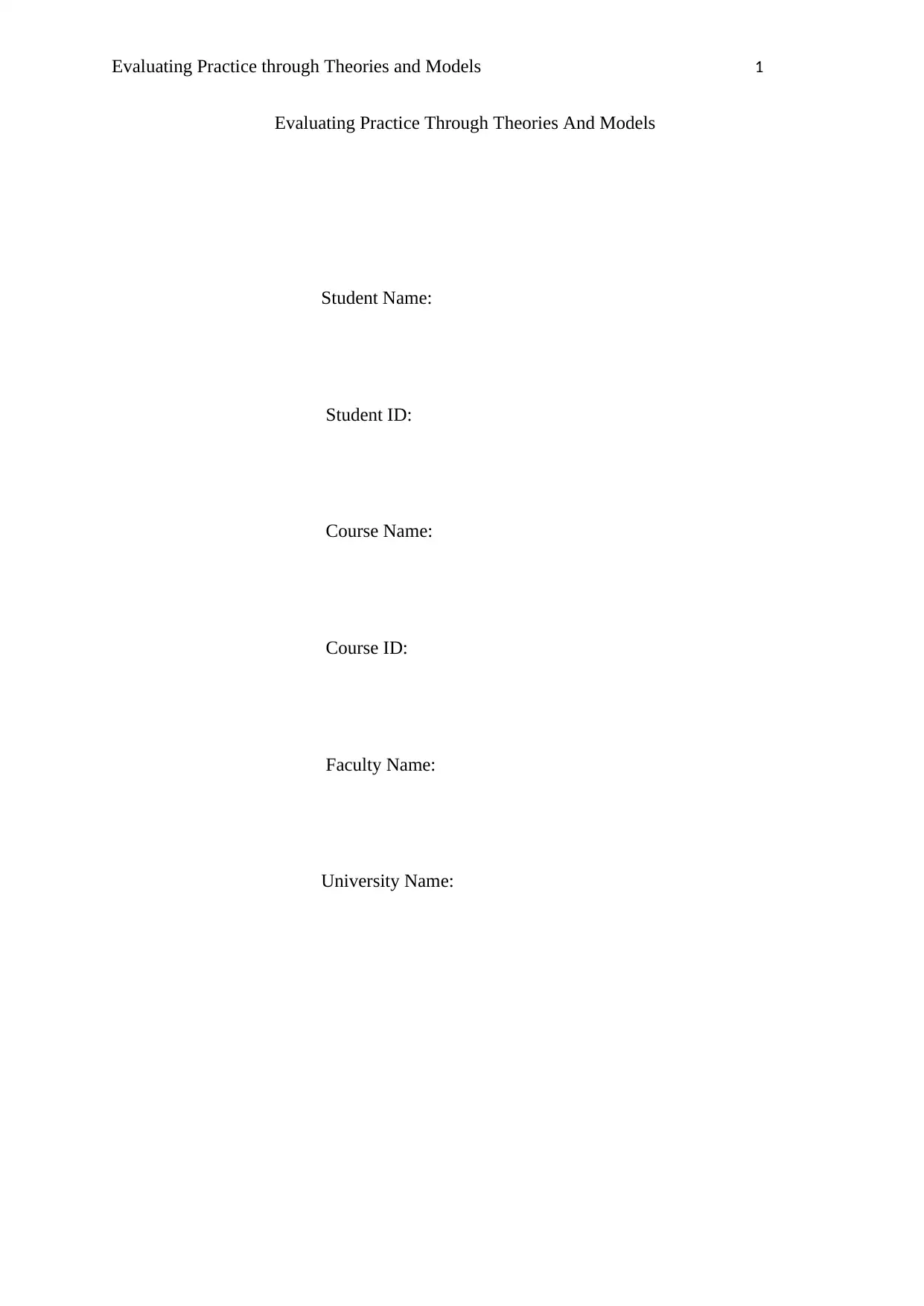
Evaluating Practice through Theories and Models 1
Evaluating Practice Through Theories And Models
Student Name:
Student ID:
Course Name:
Course ID:
Faculty Name:
University Name:
Evaluating Practice Through Theories And Models
Student Name:
Student ID:
Course Name:
Course ID:
Faculty Name:
University Name:
Paraphrase This Document
Need a fresh take? Get an instant paraphrase of this document with our AI Paraphraser
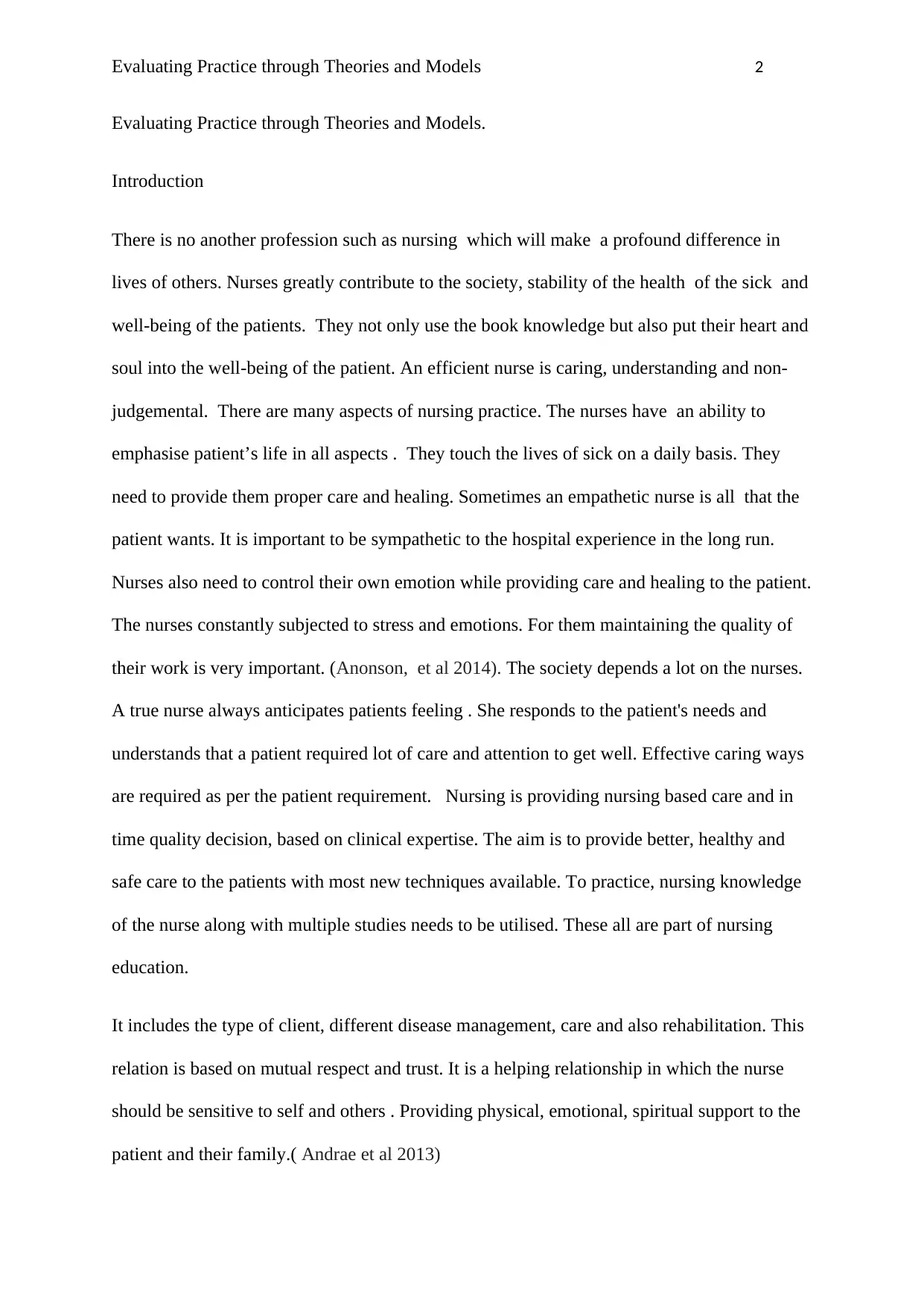
Evaluating Practice through Theories and Models 2
Evaluating Practice through Theories and Models.
Introduction
There is no another profession such as nursing which will make a profound difference in
lives of others. Nurses greatly contribute to the society, stability of the health of the sick and
well-being of the patients. They not only use the book knowledge but also put their heart and
soul into the well-being of the patient. An efficient nurse is caring, understanding and non-
judgemental. There are many aspects of nursing practice. The nurses have an ability to
emphasise patient’s life in all aspects . They touch the lives of sick on a daily basis. They
need to provide them proper care and healing. Sometimes an empathetic nurse is all that the
patient wants. It is important to be sympathetic to the hospital experience in the long run.
Nurses also need to control their own emotion while providing care and healing to the patient.
The nurses constantly subjected to stress and emotions. For them maintaining the quality of
their work is very important. (Anonson, et al 2014). The society depends a lot on the nurses.
A true nurse always anticipates patients feeling . She responds to the patient's needs and
understands that a patient required lot of care and attention to get well. Effective caring ways
are required as per the patient requirement. Nursing is providing nursing based care and in
time quality decision, based on clinical expertise. The aim is to provide better, healthy and
safe care to the patients with most new techniques available. To practice, nursing knowledge
of the nurse along with multiple studies needs to be utilised. These all are part of nursing
education.
It includes the type of client, different disease management, care and also rehabilitation. This
relation is based on mutual respect and trust. It is a helping relationship in which the nurse
should be sensitive to self and others . Providing physical, emotional, spiritual support to the
patient and their family.( Andrae et al 2013)
Evaluating Practice through Theories and Models.
Introduction
There is no another profession such as nursing which will make a profound difference in
lives of others. Nurses greatly contribute to the society, stability of the health of the sick and
well-being of the patients. They not only use the book knowledge but also put their heart and
soul into the well-being of the patient. An efficient nurse is caring, understanding and non-
judgemental. There are many aspects of nursing practice. The nurses have an ability to
emphasise patient’s life in all aspects . They touch the lives of sick on a daily basis. They
need to provide them proper care and healing. Sometimes an empathetic nurse is all that the
patient wants. It is important to be sympathetic to the hospital experience in the long run.
Nurses also need to control their own emotion while providing care and healing to the patient.
The nurses constantly subjected to stress and emotions. For them maintaining the quality of
their work is very important. (Anonson, et al 2014). The society depends a lot on the nurses.
A true nurse always anticipates patients feeling . She responds to the patient's needs and
understands that a patient required lot of care and attention to get well. Effective caring ways
are required as per the patient requirement. Nursing is providing nursing based care and in
time quality decision, based on clinical expertise. The aim is to provide better, healthy and
safe care to the patients with most new techniques available. To practice, nursing knowledge
of the nurse along with multiple studies needs to be utilised. These all are part of nursing
education.
It includes the type of client, different disease management, care and also rehabilitation. This
relation is based on mutual respect and trust. It is a helping relationship in which the nurse
should be sensitive to self and others . Providing physical, emotional, spiritual support to the
patient and their family.( Andrae et al 2013)
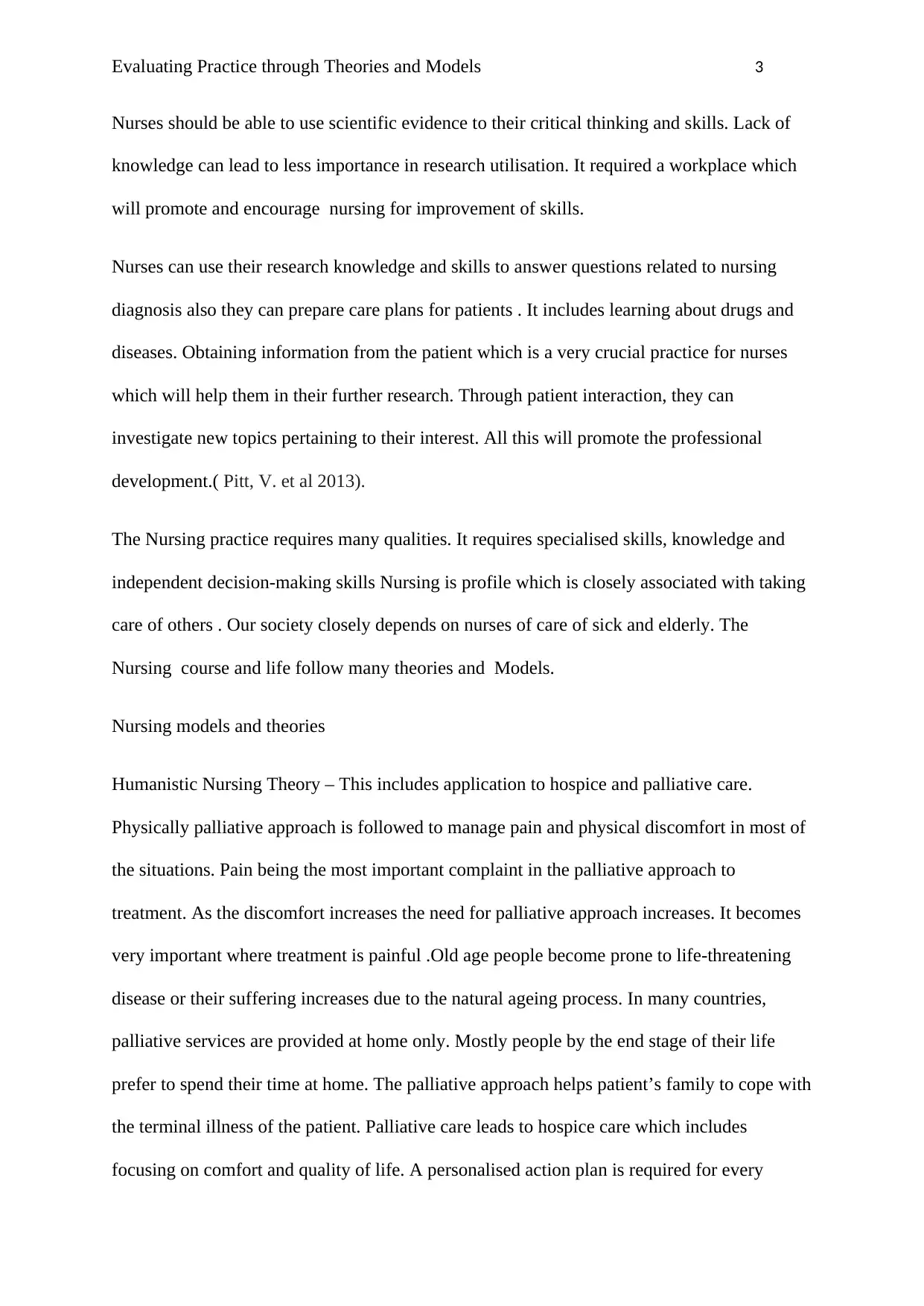
Evaluating Practice through Theories and Models 3
Nurses should be able to use scientific evidence to their critical thinking and skills. Lack of
knowledge can lead to less importance in research utilisation. It required a workplace which
will promote and encourage nursing for improvement of skills.
Nurses can use their research knowledge and skills to answer questions related to nursing
diagnosis also they can prepare care plans for patients . It includes learning about drugs and
diseases. Obtaining information from the patient which is a very crucial practice for nurses
which will help them in their further research. Through patient interaction, they can
investigate new topics pertaining to their interest. All this will promote the professional
development.( Pitt, V. et al 2013).
The Nursing practice requires many qualities. It requires specialised skills, knowledge and
independent decision-making skills Nursing is profile which is closely associated with taking
care of others . Our society closely depends on nurses of care of sick and elderly. The
Nursing course and life follow many theories and Models.
Nursing models and theories
Humanistic Nursing Theory – This includes application to hospice and palliative care.
Physically palliative approach is followed to manage pain and physical discomfort in most of
the situations. Pain being the most important complaint in the palliative approach to
treatment. As the discomfort increases the need for palliative approach increases. It becomes
very important where treatment is painful .Old age people become prone to life-threatening
disease or their suffering increases due to the natural ageing process. In many countries,
palliative services are provided at home only. Mostly people by the end stage of their life
prefer to spend their time at home. The palliative approach helps patient’s family to cope with
the terminal illness of the patient. Palliative care leads to hospice care which includes
focusing on comfort and quality of life. A personalised action plan is required for every
Nurses should be able to use scientific evidence to their critical thinking and skills. Lack of
knowledge can lead to less importance in research utilisation. It required a workplace which
will promote and encourage nursing for improvement of skills.
Nurses can use their research knowledge and skills to answer questions related to nursing
diagnosis also they can prepare care plans for patients . It includes learning about drugs and
diseases. Obtaining information from the patient which is a very crucial practice for nurses
which will help them in their further research. Through patient interaction, they can
investigate new topics pertaining to their interest. All this will promote the professional
development.( Pitt, V. et al 2013).
The Nursing practice requires many qualities. It requires specialised skills, knowledge and
independent decision-making skills Nursing is profile which is closely associated with taking
care of others . Our society closely depends on nurses of care of sick and elderly. The
Nursing course and life follow many theories and Models.
Nursing models and theories
Humanistic Nursing Theory – This includes application to hospice and palliative care.
Physically palliative approach is followed to manage pain and physical discomfort in most of
the situations. Pain being the most important complaint in the palliative approach to
treatment. As the discomfort increases the need for palliative approach increases. It becomes
very important where treatment is painful .Old age people become prone to life-threatening
disease or their suffering increases due to the natural ageing process. In many countries,
palliative services are provided at home only. Mostly people by the end stage of their life
prefer to spend their time at home. The palliative approach helps patient’s family to cope with
the terminal illness of the patient. Palliative care leads to hospice care which includes
focusing on comfort and quality of life. A personalised action plan is required for every
⊘ This is a preview!⊘
Do you want full access?
Subscribe today to unlock all pages.

Trusted by 1+ million students worldwide
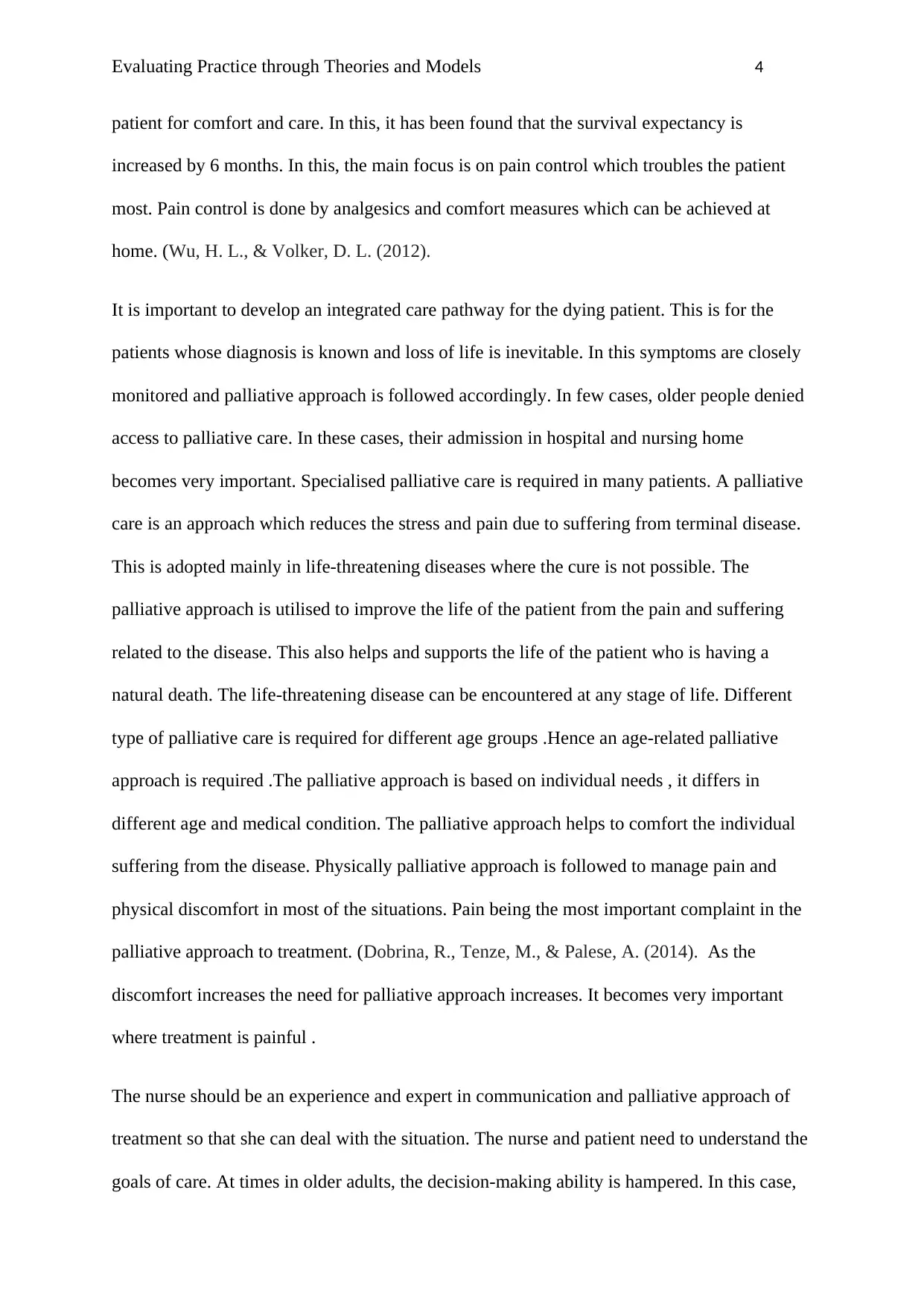
Evaluating Practice through Theories and Models 4
patient for comfort and care. In this, it has been found that the survival expectancy is
increased by 6 months. In this, the main focus is on pain control which troubles the patient
most. Pain control is done by analgesics and comfort measures which can be achieved at
home. (Wu, H. L., & Volker, D. L. (2012).
It is important to develop an integrated care pathway for the dying patient. This is for the
patients whose diagnosis is known and loss of life is inevitable. In this symptoms are closely
monitored and palliative approach is followed accordingly. In few cases, older people denied
access to palliative care. In these cases, their admission in hospital and nursing home
becomes very important. Specialised palliative care is required in many patients. A palliative
care is an approach which reduces the stress and pain due to suffering from terminal disease.
This is adopted mainly in life-threatening diseases where the cure is not possible. The
palliative approach is utilised to improve the life of the patient from the pain and suffering
related to the disease. This also helps and supports the life of the patient who is having a
natural death. The life-threatening disease can be encountered at any stage of life. Different
type of palliative care is required for different age groups .Hence an age-related palliative
approach is required .The palliative approach is based on individual needs , it differs in
different age and medical condition. The palliative approach helps to comfort the individual
suffering from the disease. Physically palliative approach is followed to manage pain and
physical discomfort in most of the situations. Pain being the most important complaint in the
palliative approach to treatment. (Dobrina, R., Tenze, M., & Palese, A. (2014). As the
discomfort increases the need for palliative approach increases. It becomes very important
where treatment is painful .
The nurse should be an experience and expert in communication and palliative approach of
treatment so that she can deal with the situation. The nurse and patient need to understand the
goals of care. At times in older adults, the decision-making ability is hampered. In this case,
patient for comfort and care. In this, it has been found that the survival expectancy is
increased by 6 months. In this, the main focus is on pain control which troubles the patient
most. Pain control is done by analgesics and comfort measures which can be achieved at
home. (Wu, H. L., & Volker, D. L. (2012).
It is important to develop an integrated care pathway for the dying patient. This is for the
patients whose diagnosis is known and loss of life is inevitable. In this symptoms are closely
monitored and palliative approach is followed accordingly. In few cases, older people denied
access to palliative care. In these cases, their admission in hospital and nursing home
becomes very important. Specialised palliative care is required in many patients. A palliative
care is an approach which reduces the stress and pain due to suffering from terminal disease.
This is adopted mainly in life-threatening diseases where the cure is not possible. The
palliative approach is utilised to improve the life of the patient from the pain and suffering
related to the disease. This also helps and supports the life of the patient who is having a
natural death. The life-threatening disease can be encountered at any stage of life. Different
type of palliative care is required for different age groups .Hence an age-related palliative
approach is required .The palliative approach is based on individual needs , it differs in
different age and medical condition. The palliative approach helps to comfort the individual
suffering from the disease. Physically palliative approach is followed to manage pain and
physical discomfort in most of the situations. Pain being the most important complaint in the
palliative approach to treatment. (Dobrina, R., Tenze, M., & Palese, A. (2014). As the
discomfort increases the need for palliative approach increases. It becomes very important
where treatment is painful .
The nurse should be an experience and expert in communication and palliative approach of
treatment so that she can deal with the situation. The nurse and patient need to understand the
goals of care. At times in older adults, the decision-making ability is hampered. In this case,
Paraphrase This Document
Need a fresh take? Get an instant paraphrase of this document with our AI Paraphraser
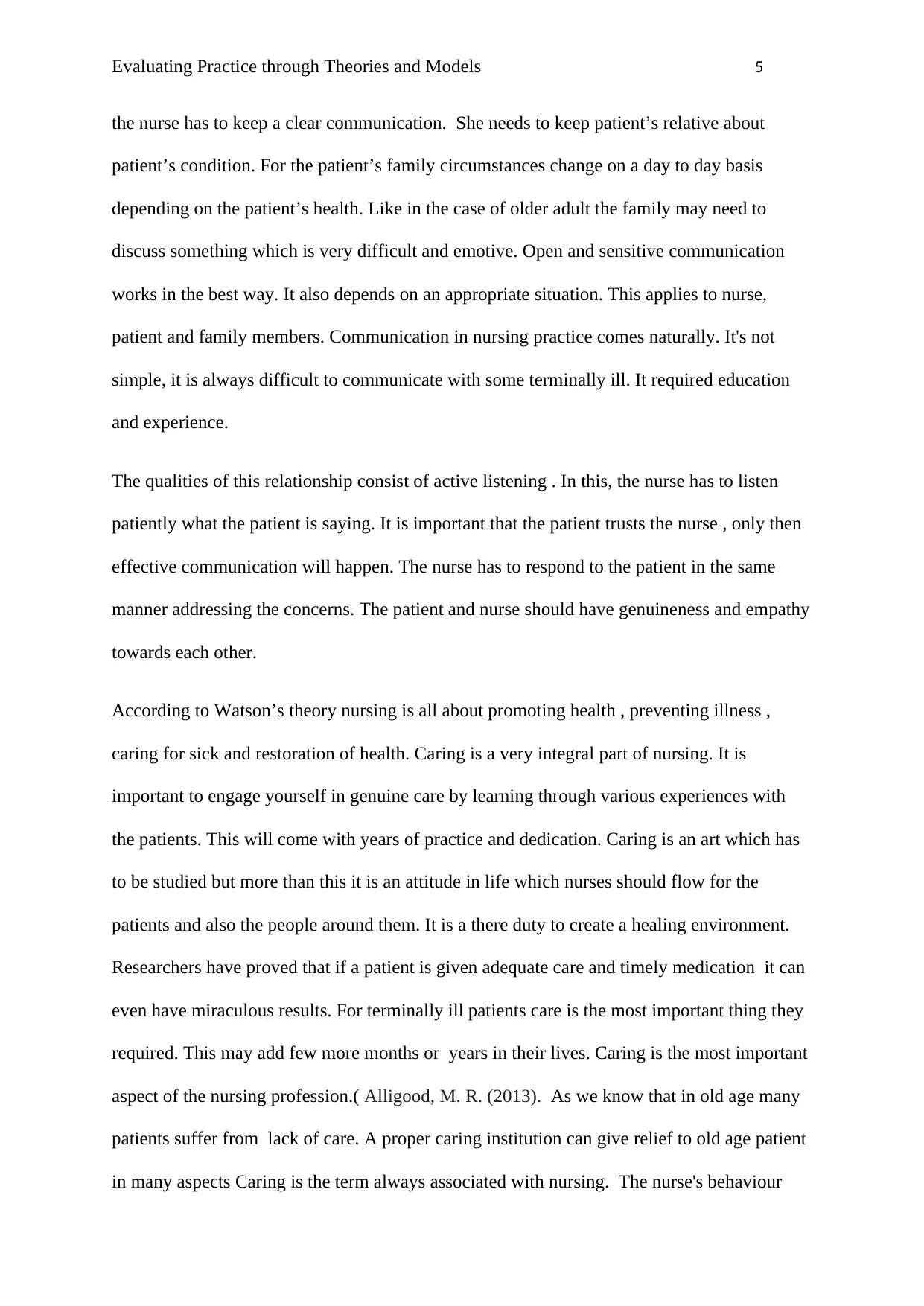
Evaluating Practice through Theories and Models 5
the nurse has to keep a clear communication. She needs to keep patient’s relative about
patient’s condition. For the patient’s family circumstances change on a day to day basis
depending on the patient’s health. Like in the case of older adult the family may need to
discuss something which is very difficult and emotive. Open and sensitive communication
works in the best way. It also depends on an appropriate situation. This applies to nurse,
patient and family members. Communication in nursing practice comes naturally. It's not
simple, it is always difficult to communicate with some terminally ill. It required education
and experience.
The qualities of this relationship consist of active listening . In this, the nurse has to listen
patiently what the patient is saying. It is important that the patient trusts the nurse , only then
effective communication will happen. The nurse has to respond to the patient in the same
manner addressing the concerns. The patient and nurse should have genuineness and empathy
towards each other.
According to Watson’s theory nursing is all about promoting health , preventing illness ,
caring for sick and restoration of health. Caring is a very integral part of nursing. It is
important to engage yourself in genuine care by learning through various experiences with
the patients. This will come with years of practice and dedication. Caring is an art which has
to be studied but more than this it is an attitude in life which nurses should flow for the
patients and also the people around them. It is a there duty to create a healing environment.
Researchers have proved that if a patient is given adequate care and timely medication it can
even have miraculous results. For terminally ill patients care is the most important thing they
required. This may add few more months or years in their lives. Caring is the most important
aspect of the nursing profession.( Alligood, M. R. (2013). As we know that in old age many
patients suffer from lack of care. A proper caring institution can give relief to old age patient
in many aspects Caring is the term always associated with nursing. The nurse's behaviour
the nurse has to keep a clear communication. She needs to keep patient’s relative about
patient’s condition. For the patient’s family circumstances change on a day to day basis
depending on the patient’s health. Like in the case of older adult the family may need to
discuss something which is very difficult and emotive. Open and sensitive communication
works in the best way. It also depends on an appropriate situation. This applies to nurse,
patient and family members. Communication in nursing practice comes naturally. It's not
simple, it is always difficult to communicate with some terminally ill. It required education
and experience.
The qualities of this relationship consist of active listening . In this, the nurse has to listen
patiently what the patient is saying. It is important that the patient trusts the nurse , only then
effective communication will happen. The nurse has to respond to the patient in the same
manner addressing the concerns. The patient and nurse should have genuineness and empathy
towards each other.
According to Watson’s theory nursing is all about promoting health , preventing illness ,
caring for sick and restoration of health. Caring is a very integral part of nursing. It is
important to engage yourself in genuine care by learning through various experiences with
the patients. This will come with years of practice and dedication. Caring is an art which has
to be studied but more than this it is an attitude in life which nurses should flow for the
patients and also the people around them. It is a there duty to create a healing environment.
Researchers have proved that if a patient is given adequate care and timely medication it can
even have miraculous results. For terminally ill patients care is the most important thing they
required. This may add few more months or years in their lives. Caring is the most important
aspect of the nursing profession.( Alligood, M. R. (2013). As we know that in old age many
patients suffer from lack of care. A proper caring institution can give relief to old age patient
in many aspects Caring is the term always associated with nursing. The nurse's behaviour
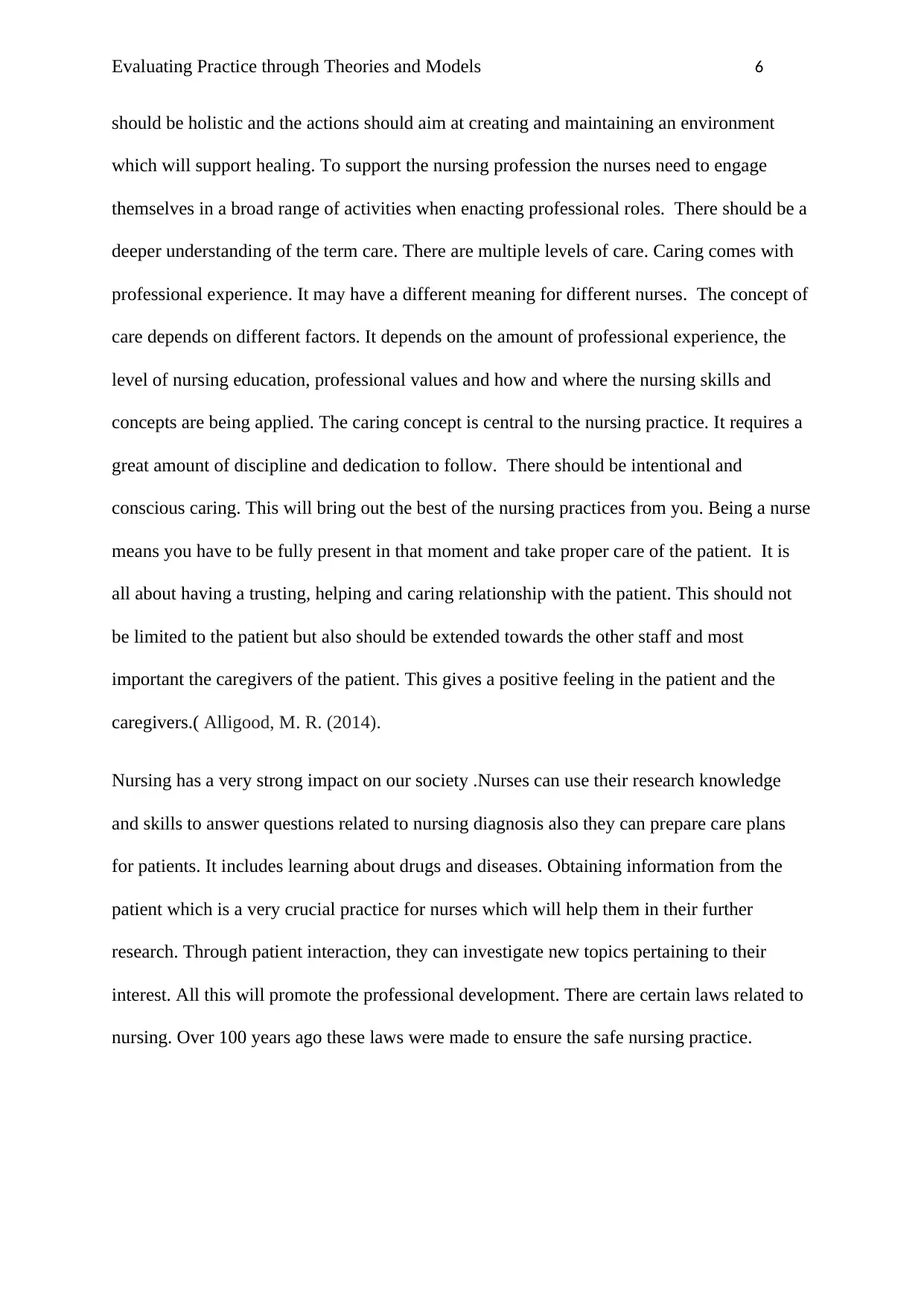
Evaluating Practice through Theories and Models 6
should be holistic and the actions should aim at creating and maintaining an environment
which will support healing. To support the nursing profession the nurses need to engage
themselves in a broad range of activities when enacting professional roles. There should be a
deeper understanding of the term care. There are multiple levels of care. Caring comes with
professional experience. It may have a different meaning for different nurses. The concept of
care depends on different factors. It depends on the amount of professional experience, the
level of nursing education, professional values and how and where the nursing skills and
concepts are being applied. The caring concept is central to the nursing practice. It requires a
great amount of discipline and dedication to follow. There should be intentional and
conscious caring. This will bring out the best of the nursing practices from you. Being a nurse
means you have to be fully present in that moment and take proper care of the patient. It is
all about having a trusting, helping and caring relationship with the patient. This should not
be limited to the patient but also should be extended towards the other staff and most
important the caregivers of the patient. This gives a positive feeling in the patient and the
caregivers.( Alligood, M. R. (2014).
Nursing has a very strong impact on our society .Nurses can use their research knowledge
and skills to answer questions related to nursing diagnosis also they can prepare care plans
for patients. It includes learning about drugs and diseases. Obtaining information from the
patient which is a very crucial practice for nurses which will help them in their further
research. Through patient interaction, they can investigate new topics pertaining to their
interest. All this will promote the professional development. There are certain laws related to
nursing. Over 100 years ago these laws were made to ensure the safe nursing practice.
should be holistic and the actions should aim at creating and maintaining an environment
which will support healing. To support the nursing profession the nurses need to engage
themselves in a broad range of activities when enacting professional roles. There should be a
deeper understanding of the term care. There are multiple levels of care. Caring comes with
professional experience. It may have a different meaning for different nurses. The concept of
care depends on different factors. It depends on the amount of professional experience, the
level of nursing education, professional values and how and where the nursing skills and
concepts are being applied. The caring concept is central to the nursing practice. It requires a
great amount of discipline and dedication to follow. There should be intentional and
conscious caring. This will bring out the best of the nursing practices from you. Being a nurse
means you have to be fully present in that moment and take proper care of the patient. It is
all about having a trusting, helping and caring relationship with the patient. This should not
be limited to the patient but also should be extended towards the other staff and most
important the caregivers of the patient. This gives a positive feeling in the patient and the
caregivers.( Alligood, M. R. (2014).
Nursing has a very strong impact on our society .Nurses can use their research knowledge
and skills to answer questions related to nursing diagnosis also they can prepare care plans
for patients. It includes learning about drugs and diseases. Obtaining information from the
patient which is a very crucial practice for nurses which will help them in their further
research. Through patient interaction, they can investigate new topics pertaining to their
interest. All this will promote the professional development. There are certain laws related to
nursing. Over 100 years ago these laws were made to ensure the safe nursing practice.
⊘ This is a preview!⊘
Do you want full access?
Subscribe today to unlock all pages.

Trusted by 1+ million students worldwide
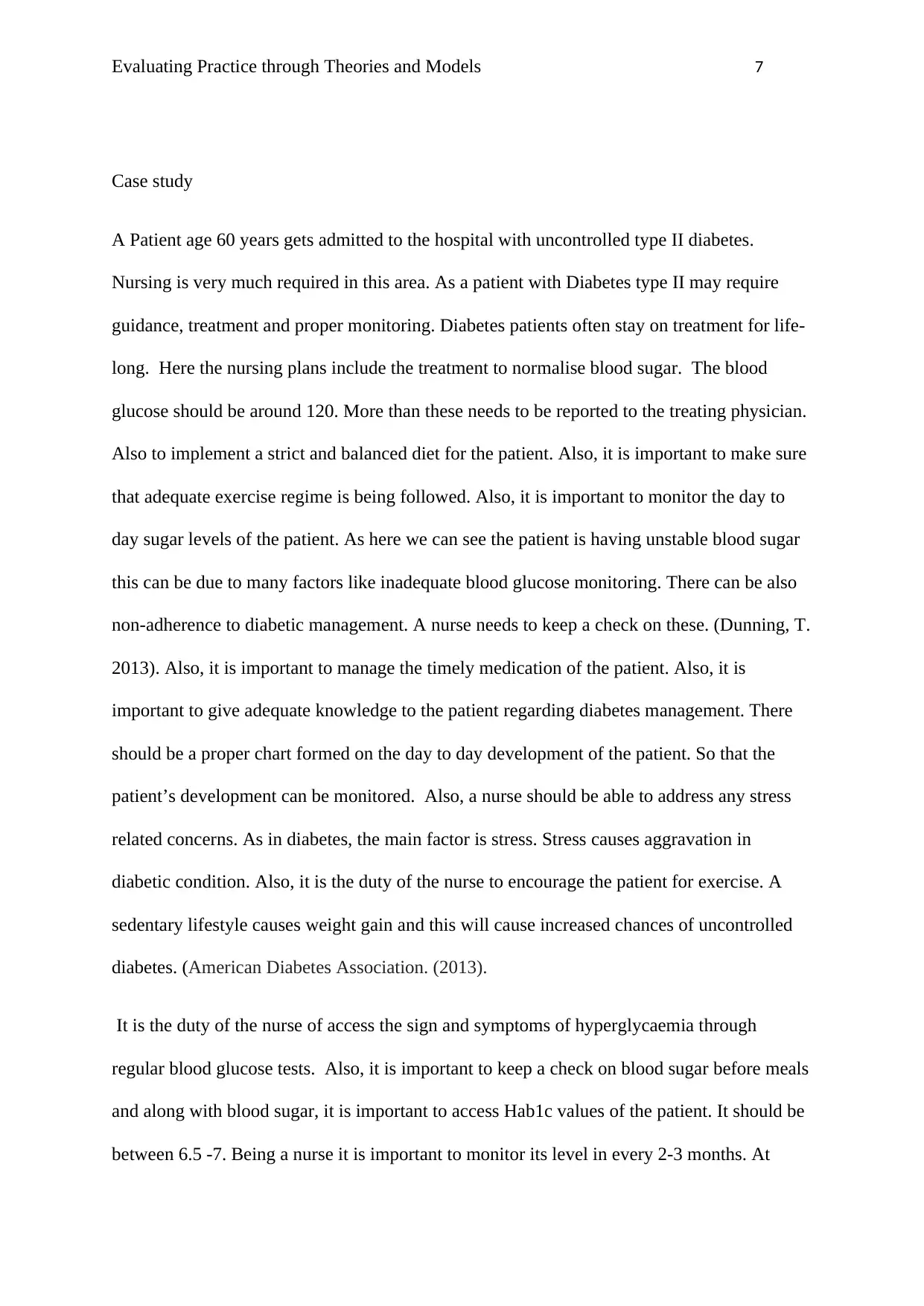
Evaluating Practice through Theories and Models 7
Case study
A Patient age 60 years gets admitted to the hospital with uncontrolled type II diabetes.
Nursing is very much required in this area. As a patient with Diabetes type II may require
guidance, treatment and proper monitoring. Diabetes patients often stay on treatment for life-
long. Here the nursing plans include the treatment to normalise blood sugar. The blood
glucose should be around 120. More than these needs to be reported to the treating physician.
Also to implement a strict and balanced diet for the patient. Also, it is important to make sure
that adequate exercise regime is being followed. Also, it is important to monitor the day to
day sugar levels of the patient. As here we can see the patient is having unstable blood sugar
this can be due to many factors like inadequate blood glucose monitoring. There can be also
non-adherence to diabetic management. A nurse needs to keep a check on these. (Dunning, T.
2013). Also, it is important to manage the timely medication of the patient. Also, it is
important to give adequate knowledge to the patient regarding diabetes management. There
should be a proper chart formed on the day to day development of the patient. So that the
patient’s development can be monitored. Also, a nurse should be able to address any stress
related concerns. As in diabetes, the main factor is stress. Stress causes aggravation in
diabetic condition. Also, it is the duty of the nurse to encourage the patient for exercise. A
sedentary lifestyle causes weight gain and this will cause increased chances of uncontrolled
diabetes. (American Diabetes Association. (2013).
It is the duty of the nurse of access the sign and symptoms of hyperglycaemia through
regular blood glucose tests. Also, it is important to keep a check on blood sugar before meals
and along with blood sugar, it is important to access Hab1c values of the patient. It should be
between 6.5 -7. Being a nurse it is important to monitor its level in every 2-3 months. At
Case study
A Patient age 60 years gets admitted to the hospital with uncontrolled type II diabetes.
Nursing is very much required in this area. As a patient with Diabetes type II may require
guidance, treatment and proper monitoring. Diabetes patients often stay on treatment for life-
long. Here the nursing plans include the treatment to normalise blood sugar. The blood
glucose should be around 120. More than these needs to be reported to the treating physician.
Also to implement a strict and balanced diet for the patient. Also, it is important to make sure
that adequate exercise regime is being followed. Also, it is important to monitor the day to
day sugar levels of the patient. As here we can see the patient is having unstable blood sugar
this can be due to many factors like inadequate blood glucose monitoring. There can be also
non-adherence to diabetic management. A nurse needs to keep a check on these. (Dunning, T.
2013). Also, it is important to manage the timely medication of the patient. Also, it is
important to give adequate knowledge to the patient regarding diabetes management. There
should be a proper chart formed on the day to day development of the patient. So that the
patient’s development can be monitored. Also, a nurse should be able to address any stress
related concerns. As in diabetes, the main factor is stress. Stress causes aggravation in
diabetic condition. Also, it is the duty of the nurse to encourage the patient for exercise. A
sedentary lifestyle causes weight gain and this will cause increased chances of uncontrolled
diabetes. (American Diabetes Association. (2013).
It is the duty of the nurse of access the sign and symptoms of hyperglycaemia through
regular blood glucose tests. Also, it is important to keep a check on blood sugar before meals
and along with blood sugar, it is important to access Hab1c values of the patient. It should be
between 6.5 -7. Being a nurse it is important to monitor its level in every 2-3 months. At
Paraphrase This Document
Need a fresh take? Get an instant paraphrase of this document with our AI Paraphraser
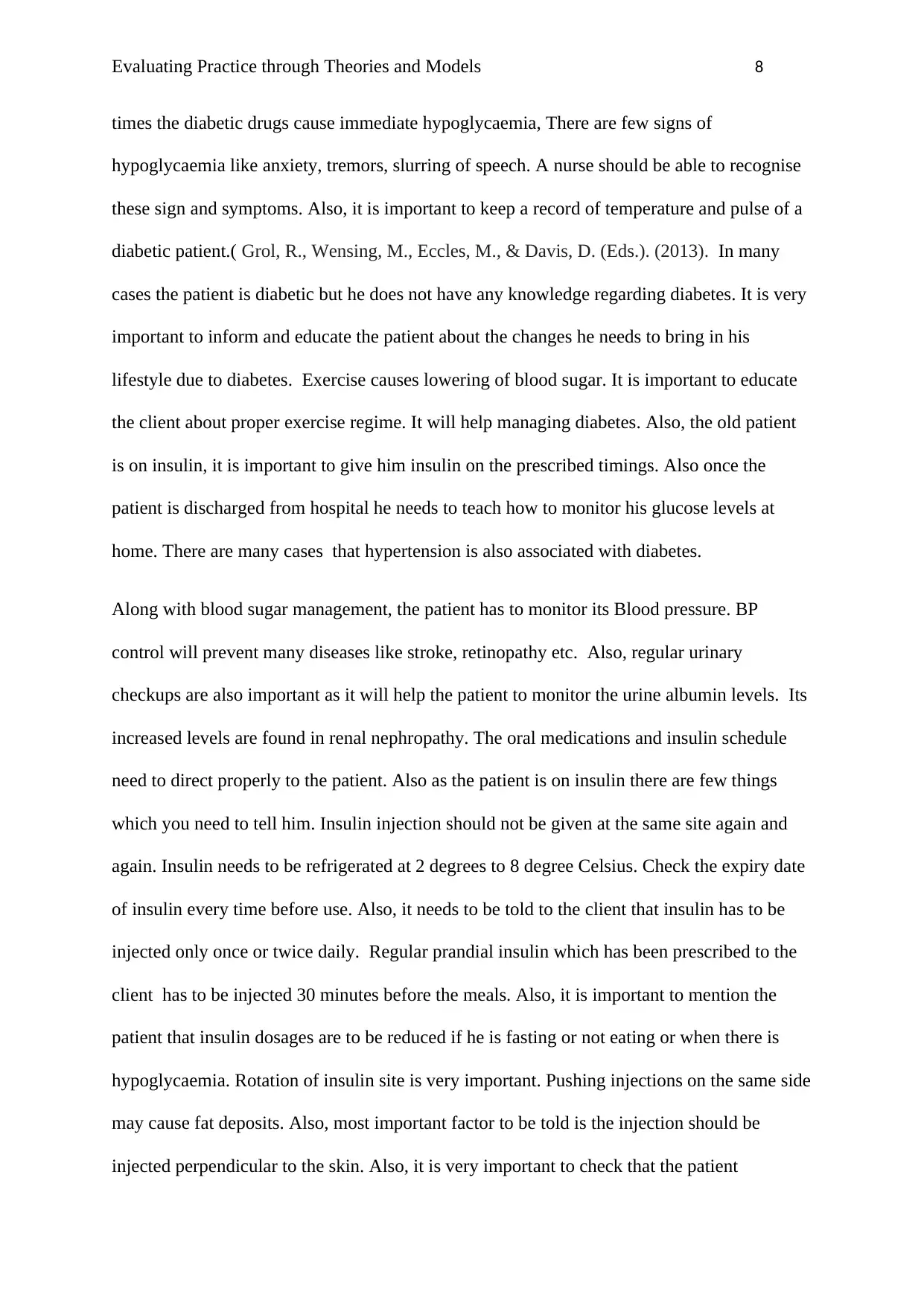
Evaluating Practice through Theories and Models 8
times the diabetic drugs cause immediate hypoglycaemia, There are few signs of
hypoglycaemia like anxiety, tremors, slurring of speech. A nurse should be able to recognise
these sign and symptoms. Also, it is important to keep a record of temperature and pulse of a
diabetic patient.( Grol, R., Wensing, M., Eccles, M., & Davis, D. (Eds.). (2013). In many
cases the patient is diabetic but he does not have any knowledge regarding diabetes. It is very
important to inform and educate the patient about the changes he needs to bring in his
lifestyle due to diabetes. Exercise causes lowering of blood sugar. It is important to educate
the client about proper exercise regime. It will help managing diabetes. Also, the old patient
is on insulin, it is important to give him insulin on the prescribed timings. Also once the
patient is discharged from hospital he needs to teach how to monitor his glucose levels at
home. There are many cases that hypertension is also associated with diabetes.
Along with blood sugar management, the patient has to monitor its Blood pressure. BP
control will prevent many diseases like stroke, retinopathy etc. Also, regular urinary
checkups are also important as it will help the patient to monitor the urine albumin levels. Its
increased levels are found in renal nephropathy. The oral medications and insulin schedule
need to direct properly to the patient. Also as the patient is on insulin there are few things
which you need to tell him. Insulin injection should not be given at the same site again and
again. Insulin needs to be refrigerated at 2 degrees to 8 degree Celsius. Check the expiry date
of insulin every time before use. Also, it needs to be told to the client that insulin has to be
injected only once or twice daily. Regular prandial insulin which has been prescribed to the
client has to be injected 30 minutes before the meals. Also, it is important to mention the
patient that insulin dosages are to be reduced if he is fasting or not eating or when there is
hypoglycaemia. Rotation of insulin site is very important. Pushing injections on the same side
may cause fat deposits. Also, most important factor to be told is the injection should be
injected perpendicular to the skin. Also, it is very important to check that the patient
times the diabetic drugs cause immediate hypoglycaemia, There are few signs of
hypoglycaemia like anxiety, tremors, slurring of speech. A nurse should be able to recognise
these sign and symptoms. Also, it is important to keep a record of temperature and pulse of a
diabetic patient.( Grol, R., Wensing, M., Eccles, M., & Davis, D. (Eds.). (2013). In many
cases the patient is diabetic but he does not have any knowledge regarding diabetes. It is very
important to inform and educate the patient about the changes he needs to bring in his
lifestyle due to diabetes. Exercise causes lowering of blood sugar. It is important to educate
the client about proper exercise regime. It will help managing diabetes. Also, the old patient
is on insulin, it is important to give him insulin on the prescribed timings. Also once the
patient is discharged from hospital he needs to teach how to monitor his glucose levels at
home. There are many cases that hypertension is also associated with diabetes.
Along with blood sugar management, the patient has to monitor its Blood pressure. BP
control will prevent many diseases like stroke, retinopathy etc. Also, regular urinary
checkups are also important as it will help the patient to monitor the urine albumin levels. Its
increased levels are found in renal nephropathy. The oral medications and insulin schedule
need to direct properly to the patient. Also as the patient is on insulin there are few things
which you need to tell him. Insulin injection should not be given at the same site again and
again. Insulin needs to be refrigerated at 2 degrees to 8 degree Celsius. Check the expiry date
of insulin every time before use. Also, it needs to be told to the client that insulin has to be
injected only once or twice daily. Regular prandial insulin which has been prescribed to the
client has to be injected 30 minutes before the meals. Also, it is important to mention the
patient that insulin dosages are to be reduced if he is fasting or not eating or when there is
hypoglycaemia. Rotation of insulin site is very important. Pushing injections on the same side
may cause fat deposits. Also, most important factor to be told is the injection should be
injected perpendicular to the skin. Also, it is very important to check that the patient
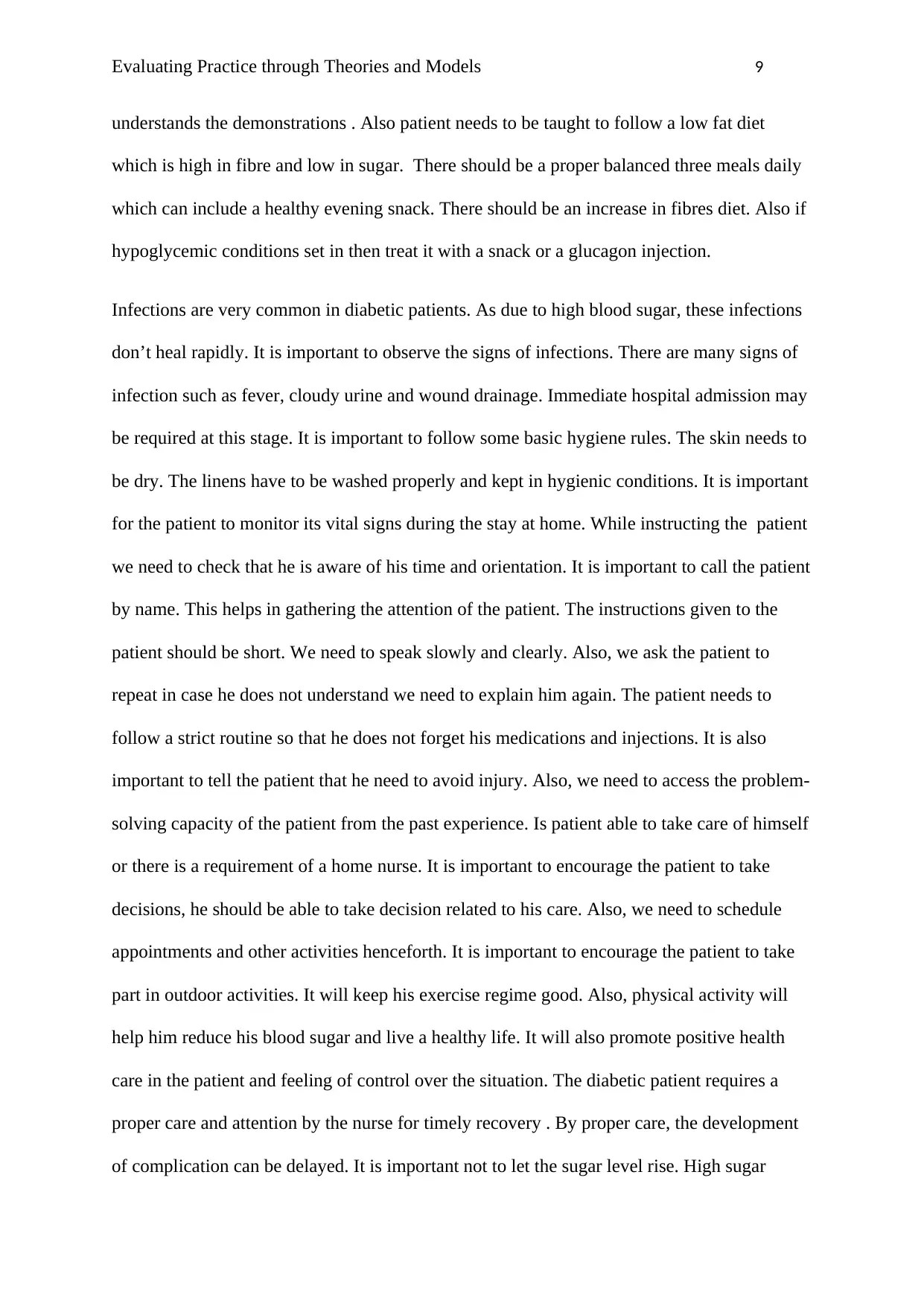
Evaluating Practice through Theories and Models 9
understands the demonstrations . Also patient needs to be taught to follow a low fat diet
which is high in fibre and low in sugar. There should be a proper balanced three meals daily
which can include a healthy evening snack. There should be an increase in fibres diet. Also if
hypoglycemic conditions set in then treat it with a snack or a glucagon injection.
Infections are very common in diabetic patients. As due to high blood sugar, these infections
don’t heal rapidly. It is important to observe the signs of infections. There are many signs of
infection such as fever, cloudy urine and wound drainage. Immediate hospital admission may
be required at this stage. It is important to follow some basic hygiene rules. The skin needs to
be dry. The linens have to be washed properly and kept in hygienic conditions. It is important
for the patient to monitor its vital signs during the stay at home. While instructing the patient
we need to check that he is aware of his time and orientation. It is important to call the patient
by name. This helps in gathering the attention of the patient. The instructions given to the
patient should be short. We need to speak slowly and clearly. Also, we ask the patient to
repeat in case he does not understand we need to explain him again. The patient needs to
follow a strict routine so that he does not forget his medications and injections. It is also
important to tell the patient that he need to avoid injury. Also, we need to access the problem-
solving capacity of the patient from the past experience. Is patient able to take care of himself
or there is a requirement of a home nurse. It is important to encourage the patient to take
decisions, he should be able to take decision related to his care. Also, we need to schedule
appointments and other activities henceforth. It is important to encourage the patient to take
part in outdoor activities. It will keep his exercise regime good. Also, physical activity will
help him reduce his blood sugar and live a healthy life. It will also promote positive health
care in the patient and feeling of control over the situation. The diabetic patient requires a
proper care and attention by the nurse for timely recovery . By proper care, the development
of complication can be delayed. It is important not to let the sugar level rise. High sugar
understands the demonstrations . Also patient needs to be taught to follow a low fat diet
which is high in fibre and low in sugar. There should be a proper balanced three meals daily
which can include a healthy evening snack. There should be an increase in fibres diet. Also if
hypoglycemic conditions set in then treat it with a snack or a glucagon injection.
Infections are very common in diabetic patients. As due to high blood sugar, these infections
don’t heal rapidly. It is important to observe the signs of infections. There are many signs of
infection such as fever, cloudy urine and wound drainage. Immediate hospital admission may
be required at this stage. It is important to follow some basic hygiene rules. The skin needs to
be dry. The linens have to be washed properly and kept in hygienic conditions. It is important
for the patient to monitor its vital signs during the stay at home. While instructing the patient
we need to check that he is aware of his time and orientation. It is important to call the patient
by name. This helps in gathering the attention of the patient. The instructions given to the
patient should be short. We need to speak slowly and clearly. Also, we ask the patient to
repeat in case he does not understand we need to explain him again. The patient needs to
follow a strict routine so that he does not forget his medications and injections. It is also
important to tell the patient that he need to avoid injury. Also, we need to access the problem-
solving capacity of the patient from the past experience. Is patient able to take care of himself
or there is a requirement of a home nurse. It is important to encourage the patient to take
decisions, he should be able to take decision related to his care. Also, we need to schedule
appointments and other activities henceforth. It is important to encourage the patient to take
part in outdoor activities. It will keep his exercise regime good. Also, physical activity will
help him reduce his blood sugar and live a healthy life. It will also promote positive health
care in the patient and feeling of control over the situation. The diabetic patient requires a
proper care and attention by the nurse for timely recovery . By proper care, the development
of complication can be delayed. It is important not to let the sugar level rise. High sugar
⊘ This is a preview!⊘
Do you want full access?
Subscribe today to unlock all pages.

Trusted by 1+ million students worldwide
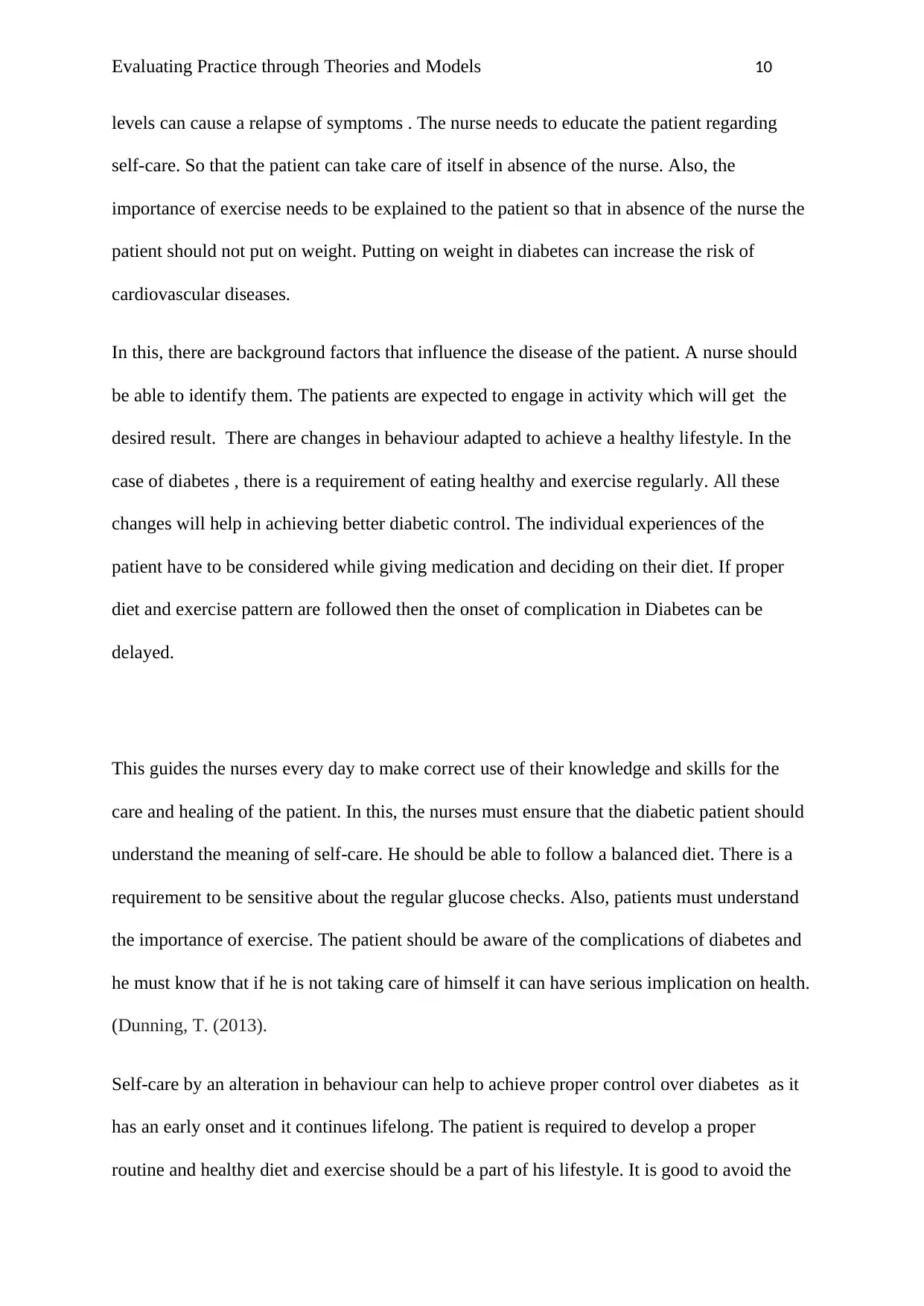
Evaluating Practice through Theories and Models 10
levels can cause a relapse of symptoms . The nurse needs to educate the patient regarding
self-care. So that the patient can take care of itself in absence of the nurse. Also, the
importance of exercise needs to be explained to the patient so that in absence of the nurse the
patient should not put on weight. Putting on weight in diabetes can increase the risk of
cardiovascular diseases.
In this, there are background factors that influence the disease of the patient. A nurse should
be able to identify them. The patients are expected to engage in activity which will get the
desired result. There are changes in behaviour adapted to achieve a healthy lifestyle. In the
case of diabetes , there is a requirement of eating healthy and exercise regularly. All these
changes will help in achieving better diabetic control. The individual experiences of the
patient have to be considered while giving medication and deciding on their diet. If proper
diet and exercise pattern are followed then the onset of complication in Diabetes can be
delayed.
This guides the nurses every day to make correct use of their knowledge and skills for the
care and healing of the patient. In this, the nurses must ensure that the diabetic patient should
understand the meaning of self-care. He should be able to follow a balanced diet. There is a
requirement to be sensitive about the regular glucose checks. Also, patients must understand
the importance of exercise. The patient should be aware of the complications of diabetes and
he must know that if he is not taking care of himself it can have serious implication on health.
(Dunning, T. (2013).
Self-care by an alteration in behaviour can help to achieve proper control over diabetes as it
has an early onset and it continues lifelong. The patient is required to develop a proper
routine and healthy diet and exercise should be a part of his lifestyle. It is good to avoid the
levels can cause a relapse of symptoms . The nurse needs to educate the patient regarding
self-care. So that the patient can take care of itself in absence of the nurse. Also, the
importance of exercise needs to be explained to the patient so that in absence of the nurse the
patient should not put on weight. Putting on weight in diabetes can increase the risk of
cardiovascular diseases.
In this, there are background factors that influence the disease of the patient. A nurse should
be able to identify them. The patients are expected to engage in activity which will get the
desired result. There are changes in behaviour adapted to achieve a healthy lifestyle. In the
case of diabetes , there is a requirement of eating healthy and exercise regularly. All these
changes will help in achieving better diabetic control. The individual experiences of the
patient have to be considered while giving medication and deciding on their diet. If proper
diet and exercise pattern are followed then the onset of complication in Diabetes can be
delayed.
This guides the nurses every day to make correct use of their knowledge and skills for the
care and healing of the patient. In this, the nurses must ensure that the diabetic patient should
understand the meaning of self-care. He should be able to follow a balanced diet. There is a
requirement to be sensitive about the regular glucose checks. Also, patients must understand
the importance of exercise. The patient should be aware of the complications of diabetes and
he must know that if he is not taking care of himself it can have serious implication on health.
(Dunning, T. (2013).
Self-care by an alteration in behaviour can help to achieve proper control over diabetes as it
has an early onset and it continues lifelong. The patient is required to develop a proper
routine and healthy diet and exercise should be a part of his lifestyle. It is good to avoid the
Paraphrase This Document
Need a fresh take? Get an instant paraphrase of this document with our AI Paraphraser
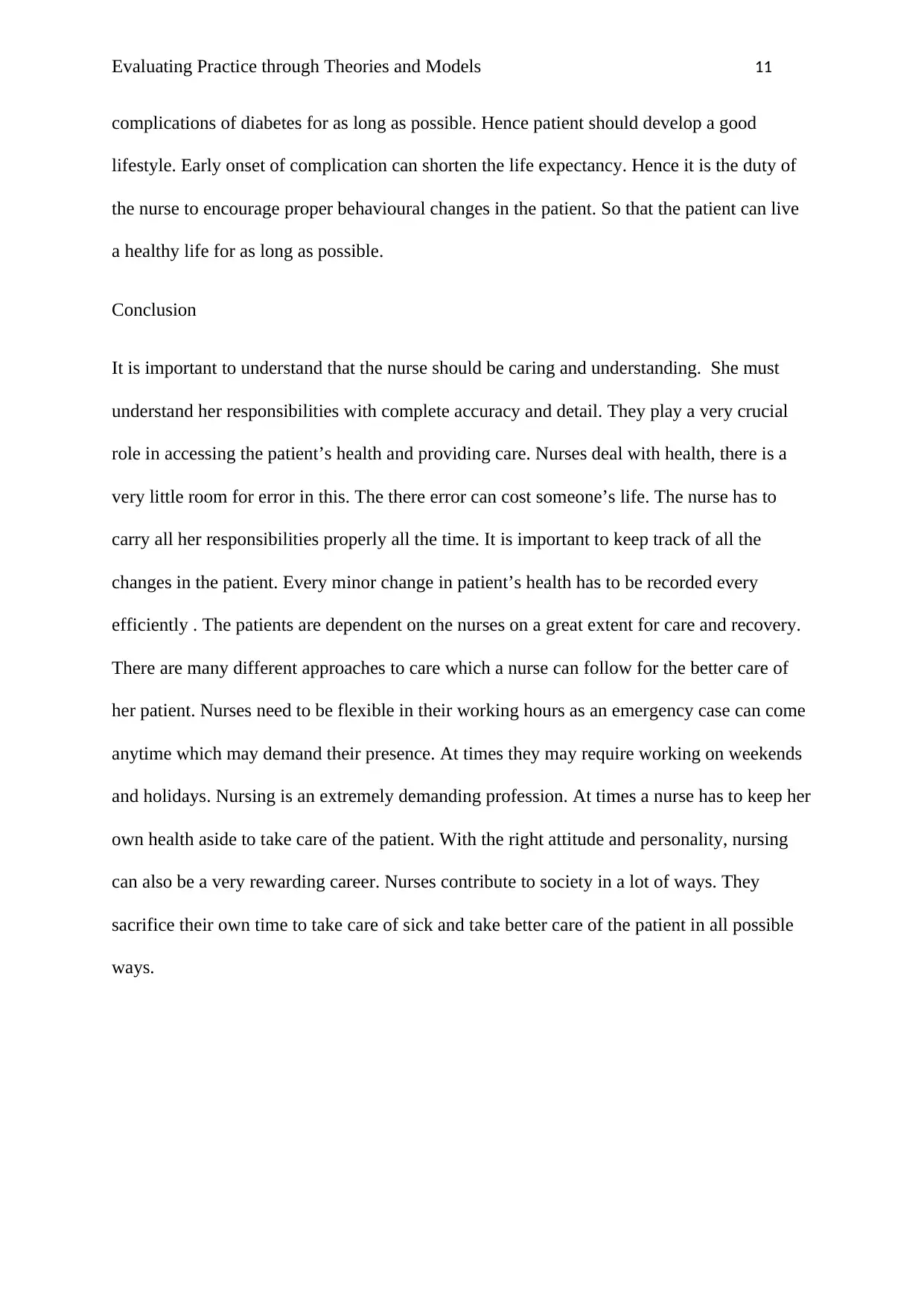
Evaluating Practice through Theories and Models 11
complications of diabetes for as long as possible. Hence patient should develop a good
lifestyle. Early onset of complication can shorten the life expectancy. Hence it is the duty of
the nurse to encourage proper behavioural changes in the patient. So that the patient can live
a healthy life for as long as possible.
Conclusion
It is important to understand that the nurse should be caring and understanding. She must
understand her responsibilities with complete accuracy and detail. They play a very crucial
role in accessing the patient’s health and providing care. Nurses deal with health, there is a
very little room for error in this. The there error can cost someone’s life. The nurse has to
carry all her responsibilities properly all the time. It is important to keep track of all the
changes in the patient. Every minor change in patient’s health has to be recorded every
efficiently . The patients are dependent on the nurses on a great extent for care and recovery.
There are many different approaches to care which a nurse can follow for the better care of
her patient. Nurses need to be flexible in their working hours as an emergency case can come
anytime which may demand their presence. At times they may require working on weekends
and holidays. Nursing is an extremely demanding profession. At times a nurse has to keep her
own health aside to take care of the patient. With the right attitude and personality, nursing
can also be a very rewarding career. Nurses contribute to society in a lot of ways. They
sacrifice their own time to take care of sick and take better care of the patient in all possible
ways.
complications of diabetes for as long as possible. Hence patient should develop a good
lifestyle. Early onset of complication can shorten the life expectancy. Hence it is the duty of
the nurse to encourage proper behavioural changes in the patient. So that the patient can live
a healthy life for as long as possible.
Conclusion
It is important to understand that the nurse should be caring and understanding. She must
understand her responsibilities with complete accuracy and detail. They play a very crucial
role in accessing the patient’s health and providing care. Nurses deal with health, there is a
very little room for error in this. The there error can cost someone’s life. The nurse has to
carry all her responsibilities properly all the time. It is important to keep track of all the
changes in the patient. Every minor change in patient’s health has to be recorded every
efficiently . The patients are dependent on the nurses on a great extent for care and recovery.
There are many different approaches to care which a nurse can follow for the better care of
her patient. Nurses need to be flexible in their working hours as an emergency case can come
anytime which may demand their presence. At times they may require working on weekends
and holidays. Nursing is an extremely demanding profession. At times a nurse has to keep her
own health aside to take care of the patient. With the right attitude and personality, nursing
can also be a very rewarding career. Nurses contribute to society in a lot of ways. They
sacrifice their own time to take care of sick and take better care of the patient in all possible
ways.
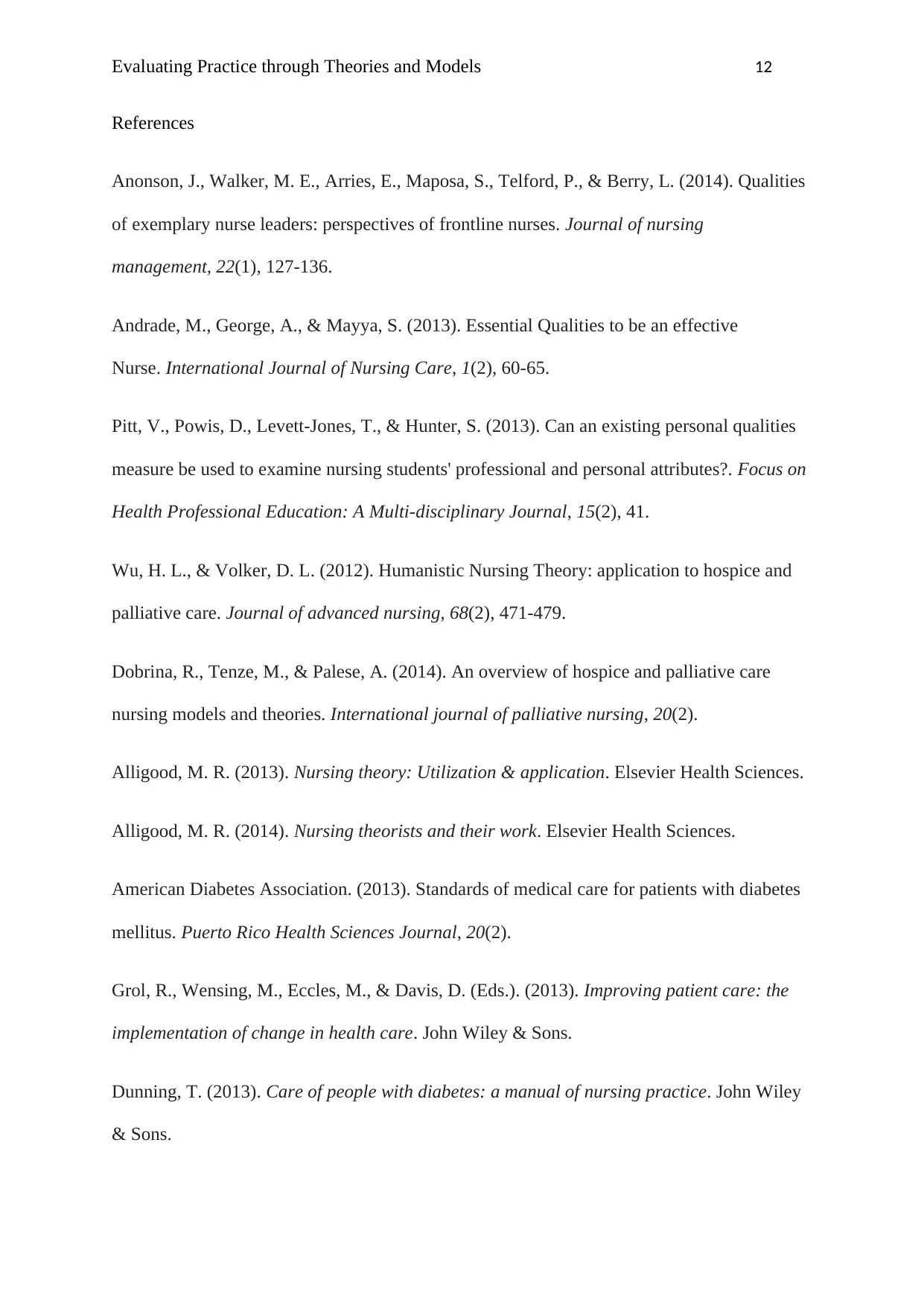
Evaluating Practice through Theories and Models 12
References
Anonson, J., Walker, M. E., Arries, E., Maposa, S., Telford, P., & Berry, L. (2014). Qualities
of exemplary nurse leaders: perspectives of frontline nurses. Journal of nursing
management, 22(1), 127-136.
Andrade, M., George, A., & Mayya, S. (2013). Essential Qualities to be an effective
Nurse. International Journal of Nursing Care, 1(2), 60-65.
Pitt, V., Powis, D., Levett-Jones, T., & Hunter, S. (2013). Can an existing personal qualities
measure be used to examine nursing students' professional and personal attributes?. Focus on
Health Professional Education: A Multi-disciplinary Journal, 15(2), 41.
Wu, H. L., & Volker, D. L. (2012). Humanistic Nursing Theory: application to hospice and
palliative care. Journal of advanced nursing, 68(2), 471-479.
Dobrina, R., Tenze, M., & Palese, A. (2014). An overview of hospice and palliative care
nursing models and theories. International journal of palliative nursing, 20(2).
Alligood, M. R. (2013). Nursing theory: Utilization & application. Elsevier Health Sciences.
Alligood, M. R. (2014). Nursing theorists and their work. Elsevier Health Sciences.
American Diabetes Association. (2013). Standards of medical care for patients with diabetes
mellitus. Puerto Rico Health Sciences Journal, 20(2).
Grol, R., Wensing, M., Eccles, M., & Davis, D. (Eds.). (2013). Improving patient care: the
implementation of change in health care. John Wiley & Sons.
Dunning, T. (2013). Care of people with diabetes: a manual of nursing practice. John Wiley
& Sons.
References
Anonson, J., Walker, M. E., Arries, E., Maposa, S., Telford, P., & Berry, L. (2014). Qualities
of exemplary nurse leaders: perspectives of frontline nurses. Journal of nursing
management, 22(1), 127-136.
Andrade, M., George, A., & Mayya, S. (2013). Essential Qualities to be an effective
Nurse. International Journal of Nursing Care, 1(2), 60-65.
Pitt, V., Powis, D., Levett-Jones, T., & Hunter, S. (2013). Can an existing personal qualities
measure be used to examine nursing students' professional and personal attributes?. Focus on
Health Professional Education: A Multi-disciplinary Journal, 15(2), 41.
Wu, H. L., & Volker, D. L. (2012). Humanistic Nursing Theory: application to hospice and
palliative care. Journal of advanced nursing, 68(2), 471-479.
Dobrina, R., Tenze, M., & Palese, A. (2014). An overview of hospice and palliative care
nursing models and theories. International journal of palliative nursing, 20(2).
Alligood, M. R. (2013). Nursing theory: Utilization & application. Elsevier Health Sciences.
Alligood, M. R. (2014). Nursing theorists and their work. Elsevier Health Sciences.
American Diabetes Association. (2013). Standards of medical care for patients with diabetes
mellitus. Puerto Rico Health Sciences Journal, 20(2).
Grol, R., Wensing, M., Eccles, M., & Davis, D. (Eds.). (2013). Improving patient care: the
implementation of change in health care. John Wiley & Sons.
Dunning, T. (2013). Care of people with diabetes: a manual of nursing practice. John Wiley
& Sons.
⊘ This is a preview!⊘
Do you want full access?
Subscribe today to unlock all pages.

Trusted by 1+ million students worldwide
1 out of 12
Related Documents
Your All-in-One AI-Powered Toolkit for Academic Success.
+13062052269
info@desklib.com
Available 24*7 on WhatsApp / Email
![[object Object]](/_next/static/media/star-bottom.7253800d.svg)
Unlock your academic potential
Copyright © 2020–2025 A2Z Services. All Rights Reserved. Developed and managed by ZUCOL.




